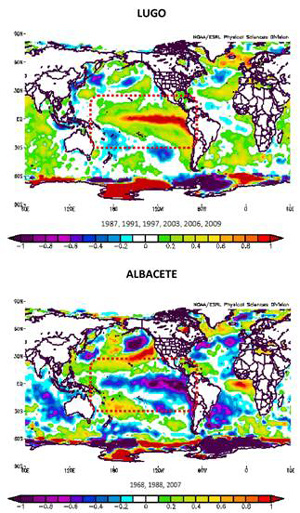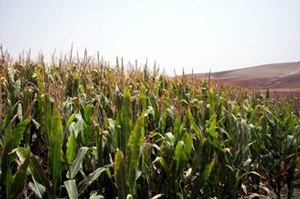
Campus Moncloa
Campus of International Excellence
Climatic variability effects on summer cropping system
Climate variability and changes in the frequency of extremes events have a direct impact on crop yield and damages. Climate anomaly projections at monthly and yearly timescale allow us to adapt a cropping system to exploit favorable conditions or reduce the effect of adverse conditions.
17/12/2012
Climate variability and changes in the frequency of extremes events have a direct impact on crop yield and damages. Climate anomaly projections at monthly and yearly timescale allow us to adapt a cropping system to exploit favorable conditions or reduce the effect of adverse conditions.The group AgSystems at the E.T.S Agronomics Engineering of the UPM and the group TROPA at the Faculty of Physical Sciences of the UCM within the framework of Moncloa Campus for the Global Change and New Energies cluster are conducting a research on the effects of climatic variability on cropping summer systems of the Iberian Peninsula.
Preliminary results indicate that the influence of the El Niño–Southern Oscillation is relevant in terms of predicting the crop yield. Thus, they carried out a multidisciplinary study related to the variations suffered on crop yields and the alterations suffered by the temperature of the sea surface at global level since the ocean represents the main source of climate predictability on these scales.
The group AgSystems has found yield data from crop models which represent the main physiological and ecological processes that lead the growth and the development of a crop by using mathematical equations. The model is calibrated and validated with independent experimental data and is taken into account weather, soil and crop management according to the simulation place.

Graphics of the sea surface temperature (SST) during the years when maize yields were low (it is shown at the bottom of the figures). The low yields found in Lugo (upper fig.) are associated to the warming or the El Niño, and the low yields found in Albacette (bottom fig.) are associated to the cooling or La Niña.
Irrigated maize is the reference crop used to represent summer crops. Particularly in this study, simulated maize yields were computed with CERES-maize model and were calibrated and validated with three opposite locations in Spain: Lugo, Getafe and Albacete which have different temperature and rainfall. They did daily simulations with observed weather data (radiation, precipitation, maximum and minimum temperature) available for these locations and provided by the Agencia Estatal de Meteorología (AEMET). They introduced profiles of real soil, variability of maize and specific and adapted use on the simulations to each location.
In collaboration with the group TROPA-UCM, the fluctuations in the performance during the study were related to the variability of ocean at global level with months in advance finding significant links with the influence of the El Niño–Southern Oscillation (or La Niña). These links were clearer during years of extreme yields (high and low yields).
The El Niño phenomenon is a warming in the Eastern Equatorial Pacific which affects not only the tropics but also midlatitudes. The opposite phenomenon called La Niña is characterized by a cooling of the waters in the area. The two phenomenons affect the global weather but these effects are different depending on the area.
Particularly, the events of the La Niña in the northwest of Spain, represented by Lugo, are highly associated to the increase of maize yields and a decrease during the years of the El Niño. This relationship is very clear and appears in spring when crop are sown.
However, years of the La Niña were associated with a decrease of maize yields being possible to predict this decrease from previous seasons of the crop cycle in the centre and southeast of Spain (Albacete and Getafe). Nevertheless, in this area of Spain there is not a clear increase of yields during years of the El Niño.
The connections found can be helpful to anticipate yield anomalies (higher or lower than usual) what can help us to adapt crop systems in advance: insurance contracts, changes in sowing dates, crop, choice of species and varieties, as well as changes in the management of fertilization and irrigation.
Author of the article: Mirian Capa
Tag: Global Change and new Energies Source: CEI Campus Moncloa
Event date:
17/12/2012

